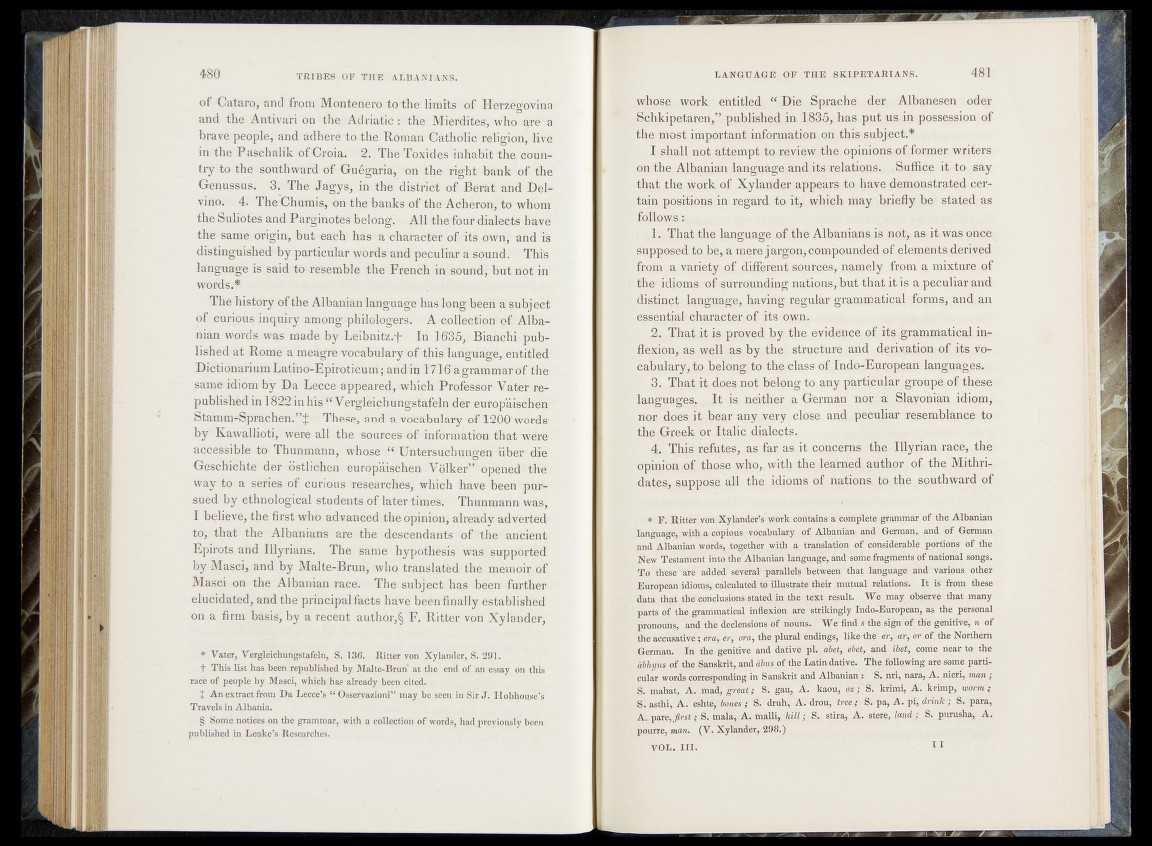
I i l l
o f C a ta rO j and from Montenero to the limits of Herzegovina
and the Antivari on the Adriatic: the Mierdites, who ^re a
brave people, and adhere to the Roman Catholic religion, live
in the Paschalik of Croia. 2. The Toxliisdiihabit the conn-
try to the sWthward o f Gudgaria, on the right bank of the
Genussus. 3; The Jagys, in the district of Berat and Del-
vino. 4. The Chumis, on the banks of the Acheron, to whom
the Suliotes and Parginotes belong. All the four dialects have
the same origin, but each has a character of its own, and is
distinguished by particular words and peculiar a sound. This
language is said to resemble the French in sound, but not in
words.*
The history of the Albanian language has long been a subject
o f curious inquiry among philologers. A collecrion of Albanian
words was made b y Leibnitz.-f In 1635, Bianchi published
at Rome a meagre vocabulary of this language, entitled
Dictionarium Latino-Epiroticum; and in 1716 agrafemarof the
sameridiom by Da Lecce appeared, which Professor Vater republished
in 1822 in his “ Vergleichungstafeln der europäischen 1
Stamm-Sprachen.”^; These, and a vocabulary of.däfkhwdrds
by Kawallioti, were all the sourcegrof information that were
accessible to Thunmann, whose “ Untersuchungen 'über' die
Geschichte der'östlichen europäischen Völker^opened the
way to a series of curious researches, which have been pursued
by ethnological students of later times. Thunmann was,.
I believe, the first who advanced the opinion, already adverted
to, that the Albanians are the descendants o f ’the ancient
Epirots and Illyrians. The same hypothesis was supported
by Masci, and by Malte-Brun, who translated the meincaribl*
Maser on the Albanian race. The subject has been further
elucidated, and the principal facts have been finaliy established
on a. firm basis, by a recent author,§ F. Ritter von Xylander, *§
* Vater, Vergleichungstafeln, S. 136. Ritter von Xylander, S. 291.
t This Hst has been republished by Malte-Brun at the end of an essay on this
race of people by Masci, which has already been cited. ■
+ An extract from Da Lecce’s “ OsseTvazioni” may be seen in Sir J . Hothouse's
Travels in Albania.
§ Some notices on the grammar, with a collection of words, had previously been
published in Leake’s Researches'.
whose work entitled “ Die Sprache der Albanesen oder
Schkipetaren^’-published in 1835, has put us in possession of
the most important information, on thisvgubject.*
- I shall not attempts© review the opinions of former writers
on the Albanian language,ancl'its relations.,, .Suffice it, to say
that the work of Xylander, appears to-have demonstrated certain
positions in regard to» it,;/which may briefly be stated as
follows L j
;■ .yit.^That the language ,of the Albanians is npt^as it was once(
supposed to be, a mere jargon,compoupde^ef eleurents derived
from* a variety of different sj^-i^esynamely froK^ a mixture of
the^idioms of1 surrounding nations, but th a tit is a^peiculiar and
distinct language,). ha.vin^g^egulfupgrammatical formg* and;$n
essential charactpilof its own.
s ' 2^.,.That it is proved by the its grammatical inflexion,,
as well as by_the sirucffist^ and derivation of jts.-vo-*-,
cabulary, to, bpjpng|fp th^eljjfess of Indp^Eurppean. languages-;
fi l L That.it dpes not belong to, any? particular^groupe of these/
la n g u a g e It is neither a German n o r, a ' Slavonian idiom,
nor does it bear any fery ploseuanck*peculiar pgemblance to
the GreeV©^ Itajic.dialects.
4; This refutes, as farf,as it conceals ..the Illyrian race, the
opinion of ^lase.wjjp, w ith ,t^ le a rn e d a u th o r so/ the Mithri^
dates..,, suppose all thp; idioms of natipnp, t o ^ e ^puthward of
* F. R itte r voivXylanderVwork contains a complete grammar of the Albanian
language, withia copious, vocabulary of Albanian andGerm-an,, and, of German
and Albanian words, together with a translation^ of considerable portions of the
fNew Testament into the^Albanian language,’and someTragihenfs of national songs.
'Tö thele* are added several'parallels hetweep^that language' and"various other
European idioms,, calcüläted.to illustrate their mutual relation®,«, It^-is from these
data that the'conclusions stated in the,.Aext. result. W e t may? observe that .many
parts qf the grammatical inflexion are strikingly Indo-European, as the personal
pronouns, and the declensions of nouhs. We find s the sign o f the geniti ve, n of
'the* accusative; era, er, ora, the plural endings, HEe tKfet4sl®^'0Oof?the Northern
German. In the genitive and dative« p L a6et,.,e6ei, and ib e t, come near to-the
ä b h y u s of the Sanskrit, ai\d ufiMs-of the^Latin dative.^ Theu|^owing are some particular
words corresponding, in Sanskrit and Albanian: S. nri, nara, A. men, m a n j
S. mahat, A. mad, £r'eat; S. g a u , kaou,‘Ä ^ S/. krimi, A. krmip,« wofM^
asthi, A. eshte, bones /'S .f truhy k^dW>hfee>| S. pa, A. pi, d r in k s S. para,
A. pare,j&ttt*S. mala, A,, malll, h ill s|xg^ A. store, I m d j S. piirusl^, ,A.
ppiirre, m a n . (V. Xylander, 298.)
VOL. III. I I